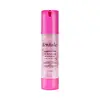What's inside
What's inside
 Key Ingredients
Key Ingredients

 Benefits
Benefits

 Concerns
Concerns

 Ingredients Side-by-side
Ingredients Side-by-side

Water
Skin ConditioningGlycerin
HumectantDimethicone
EmollientPropanediol
SolventNiacinamide
SmoothingGlyceryl Glucoside
HumectantPropylene Glycol
HumectantDicaprylyl Carbonate
EmollientCentella Asiatica Extract
CleansingBetaine
HumectantPhenoxyethanol
PreservativeCapryloyl Glycine
CleansingAzelaic Acid
BufferingAllantoin
Skin ConditioningCyclopentasiloxane
EmollientAmmonium Acryloyldimethyltaurate/Vp Copolymer
Carbomer
Emulsion StabilisingEthylhexylglycerin
Skin ConditioningCalcium Alginate
MaskingXanthan Gum
EmulsifyingAgar
MaskingMica
Cosmetic Colorant1,2-Hexanediol
Skin ConditioningHydroxyacetophenone
AntioxidantSodium Hydroxide
BufferingDisodium EDTA
Parfum
MaskingCI 77891
Cosmetic ColorantCI 12490
Cosmetic ColorantCI 74160
Cosmetic ColorantWater, Glycerin, Dimethicone, Propanediol, Niacinamide, Glyceryl Glucoside, Propylene Glycol, Dicaprylyl Carbonate, Centella Asiatica Extract, Betaine, Phenoxyethanol, Capryloyl Glycine, Azelaic Acid, Allantoin, Cyclopentasiloxane, Ammonium Acryloyldimethyltaurate/Vp Copolymer, Carbomer, Ethylhexylglycerin, Calcium Alginate, Xanthan Gum, Agar, Mica, 1,2-Hexanediol, Hydroxyacetophenone, Sodium Hydroxide, Disodium EDTA, Parfum, CI 77891, CI 12490, CI 74160
Water
Skin ConditioningDisodium EDTA
Acrylates/C10-30 Alkyl Acrylate Crosspolymer
Emulsion StabilisingAminomethyl Propanol
BufferingPEG/PPG-17/6 Copolymer
SolventGlycerin
HumectantHydrolyzed Sclerotium Gum
HumectantSodium Hyaluronate
HumectantCoco-Caprylate/Caprate
EmollientPEG-20-PPG-10 Glyceryl Stearate
EmulsifyingVinyl Dimethicone/Methicone Silsesquioxane Crosspolymer
Cyclopentasiloxane
EmollientPhenoxyethanol
PreservativeSodium Benzoate
MaskingPotassium Sorbate
PreservativeCeramide 3
Skin ConditioningCaprylic/Capric Triglyceride
MaskingCeteareth-20
CleansingPolyglyceryl-10 Stearate
Skin Conditioning1,2-Hexanediol
Skin ConditioningWater, Disodium EDTA, Acrylates/C10-30 Alkyl Acrylate Crosspolymer, Aminomethyl Propanol, PEG/PPG-17/6 Copolymer, Glycerin, Hydrolyzed Sclerotium Gum, Sodium Hyaluronate, Coco-Caprylate/Caprate, PEG-20-PPG-10 Glyceryl Stearate, Vinyl Dimethicone/Methicone Silsesquioxane Crosspolymer, Cyclopentasiloxane, Phenoxyethanol, Sodium Benzoate, Potassium Sorbate, Ceramide 3, Caprylic/Capric Triglyceride, Ceteareth-20, Polyglyceryl-10 Stearate, 1,2-Hexanediol
Ingredients Explained
These ingredients are found in both products.
Ingredients higher up in an ingredient list are typically present in a larger amount.
1,2-Hexanediol is a synthetic liquid and another multi-functional powerhouse.
It is a:
- Humectant, drawing moisture into the skin
- Emollient, helping to soften skin
- Solvent, dispersing and stabilizing formulas
- Preservative booster, enhancing the antimicrobial activity of other preservatives
Cyclopentasiloxane, or D5, is a silicone used to improve texture of products and trap moisture.
D5 is considered lightweight and volatile. Volatile means it evaporates quickly after application. Once evaporated, D5 leaves a thin barrier that helps keep skin hydrated.
It is also an emollient. Emollients help soften the skin and prevent water loss. Silicones create a silky texture in products. D5 helps other ingredients become more spreadable.
Studies show D5 is safe to use in skincare products. We recommend speaking with a skincare professional if you have concerns.
Learn more about CyclopentasiloxaneDisodium EDTA plays a role in making products more stable by aiding other preservatives.
It is a chelating agent, meaning it neutralizes metal ions that may be found in a product.
Disodium EDTA is a salt of edetic acid and is found to be safe in cosmetic ingredients.
Learn more about Disodium EDTAGlycerin is already naturally found in your skin. It helps moisturize and protect your skin.
A study from 2016 found glycerin to be more effective as a humectant than AHAs and hyaluronic acid.
As a humectant, it helps the skin stay hydrated by pulling moisture to your skin. The low molecular weight of glycerin allows it to pull moisture into the deeper layers of your skin.
Hydrated skin improves your skin barrier; Your skin barrier helps protect against irritants and bacteria.
Glycerin has also been found to have antimicrobial and antiviral properties. Due to these properties, glycerin is often used in wound and burn treatments.
In cosmetics, glycerin is usually derived from plants such as soybean or palm. However, it can also be sourced from animals, such as tallow or animal fat.
This ingredient is organic, colorless, odorless, and non-toxic.
Glycerin is the name for this ingredient in American English. British English uses Glycerol/Glycerine.
Learn more about GlycerinPhenoxyethanol is a preservative that has germicide, antimicrobial, and aromatic properties. Studies show that phenoxyethanol can prevent microbial growth. By itself, it has a scent that is similar to that of a rose.
It's often used in formulations along with Caprylyl Glycol to preserve the shelf life of products.
Water. It's the most common cosmetic ingredient of all. You'll usually see it at the top of ingredient lists, meaning that it makes up the largest part of the product.
So why is it so popular? Water most often acts as a solvent - this means that it helps dissolve other ingredients into the formulation.
You'll also recognize water as that liquid we all need to stay alive. If you see this, drink a glass of water. Stay hydrated!
Learn more about Water